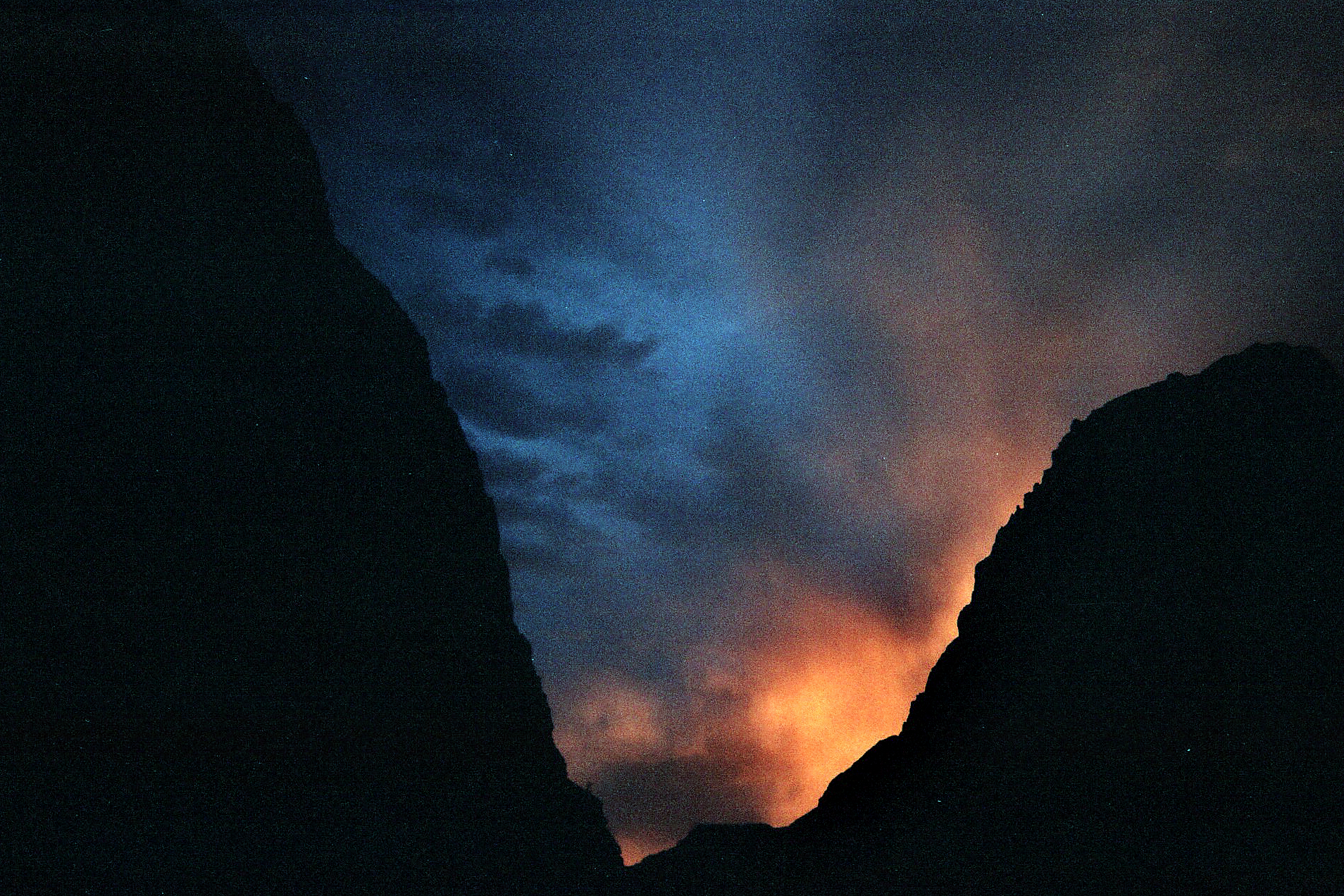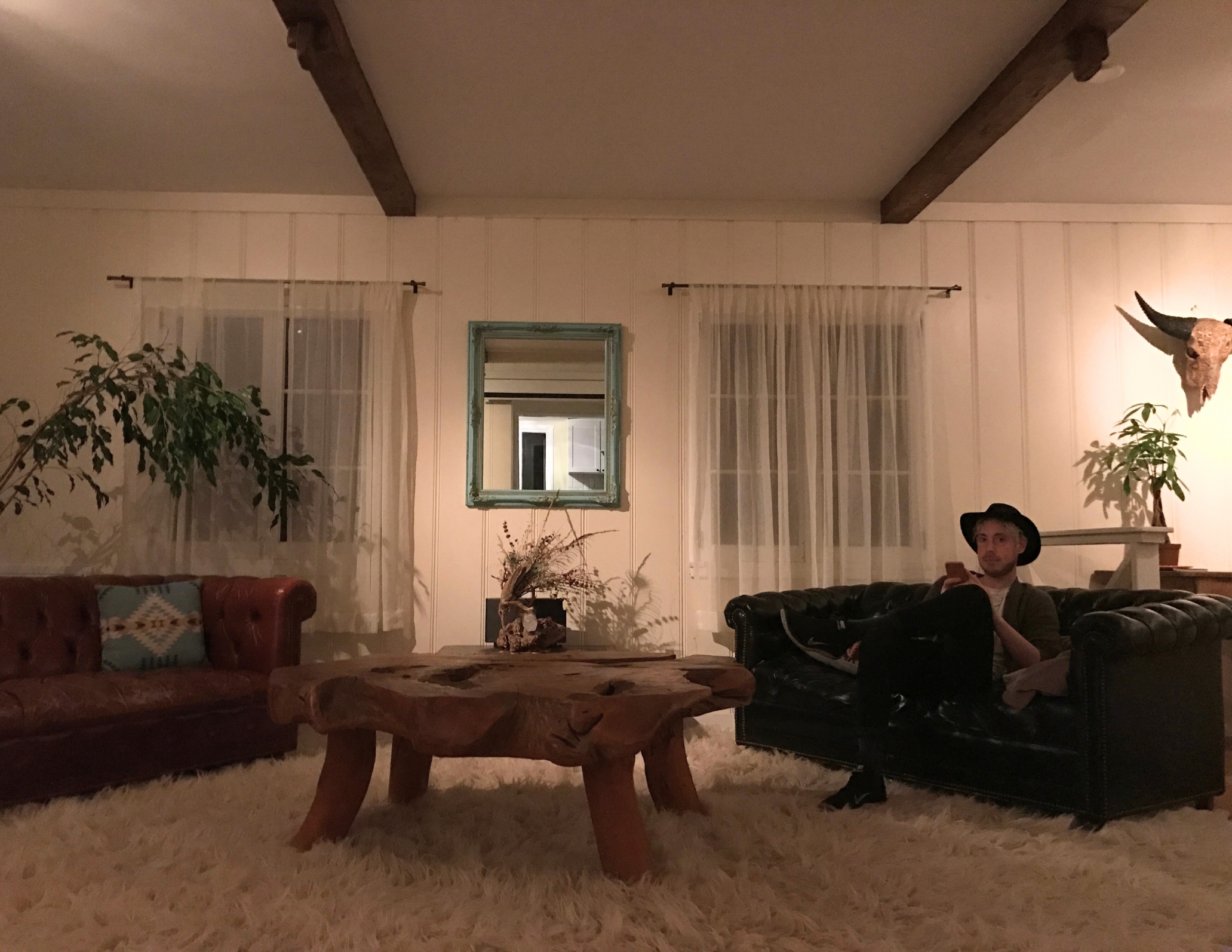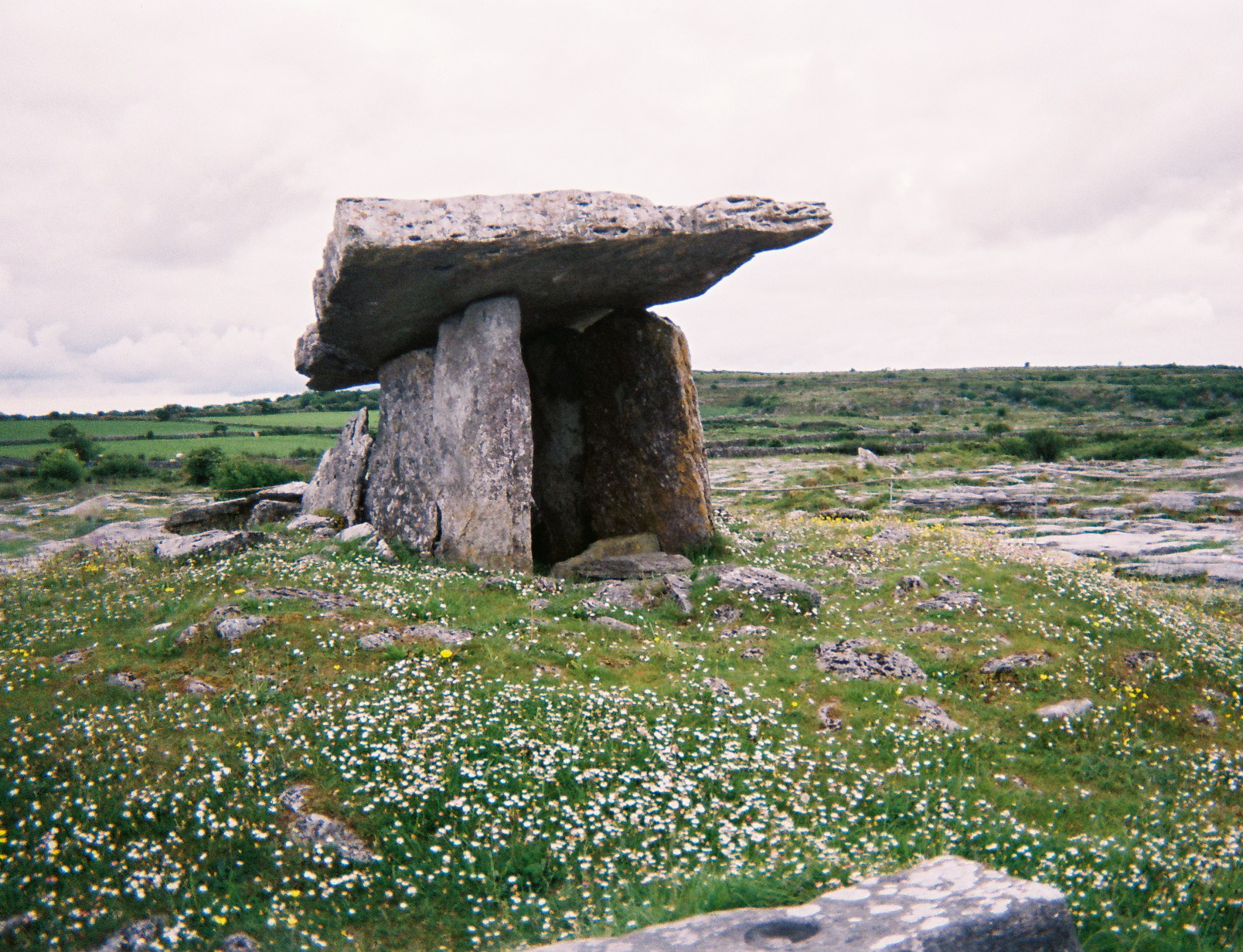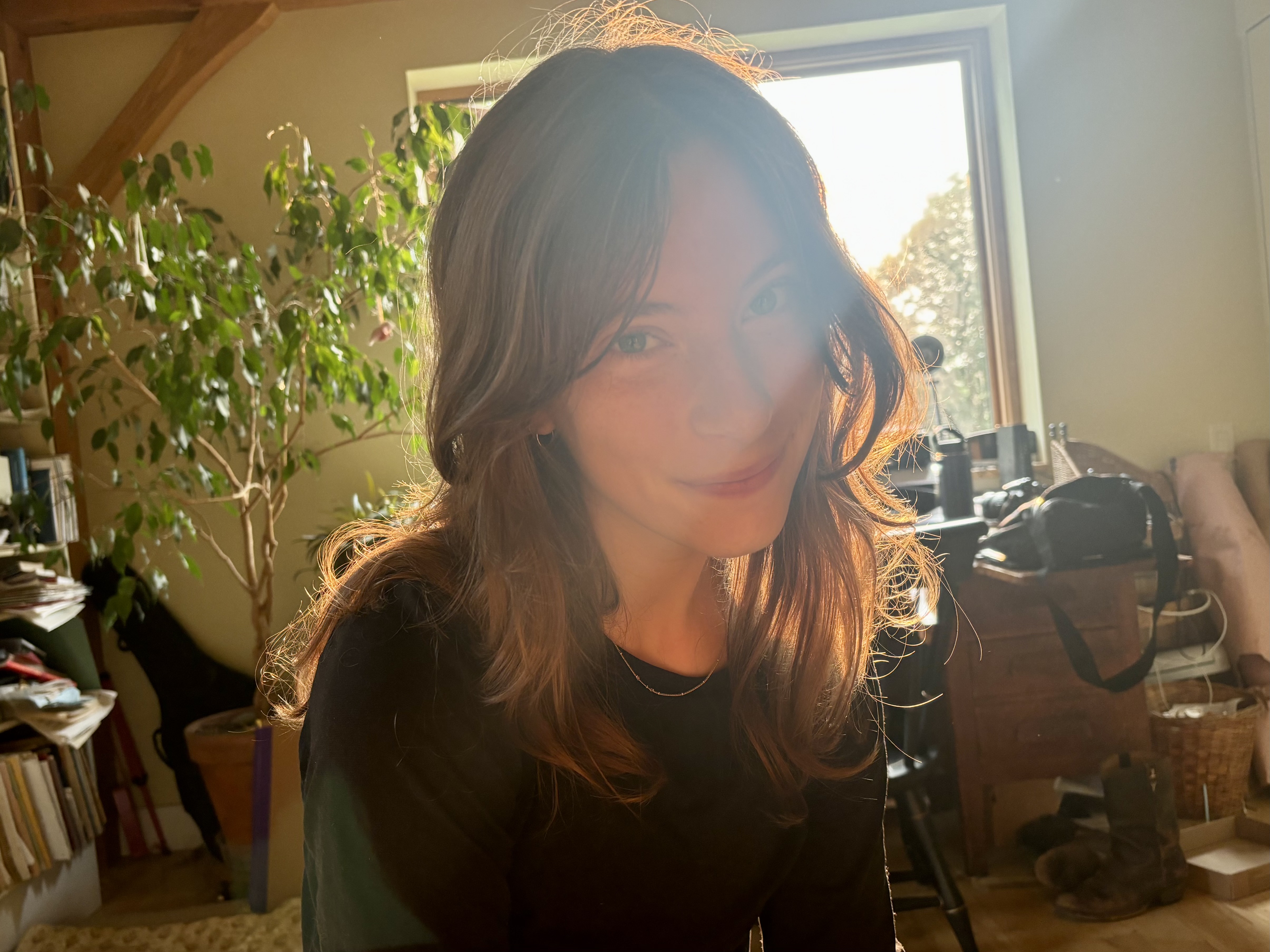According to Ellayo, good lullabies are haunting. “We wanted the song to carry notes of sleep and rest,” the artist said, describing the creation of “Mary, Mary (Part One),” the last track on her debut EP, For Miriam, “but at the same time, there’s an eerie quality to the piece. That’s what makes it a lullaby.” Produced by Jon Castelli and released in 2018, Ellayo’s For Miriam is a meditation on bravery through breath. Drawing inspiration from Gregorian chants, birth doula breath techniques, Swedish cow herding calls, and traditional lullabies, the EP weaves a sonic journey toward a comforting kind of darkness.
Ellayo is the vocal project of Natalia Schwien Scott, a musician, herbalist, wildlife rescue & rehabilitation apprentice, and PhD student in the Study of Religion at Harvard University. Through their music, research, and relationships, Natalia explores ontologies of personhood beyond the human, seeking to honor the animate and relational world.
In an interview, we spoke about ego-death, myth, rest-as-risk, neurofeedback therapy, posthumanist approaches to the internet, and the comforting eeriness of lullabies.
***
Olivia Q. Pintair: You describe For Miriam as a “narrative meditation on bravery through space and breath.” What brought the theme of bravery to the center of the EP?
Natalia Schwien Scott: I worked on this EP while leaving behind a whole life——a full time role in the music industry, a series of painful relationships, the city I had called home for nearly ten years. I went through this massive deconstruction of myself and the narratives I had wrapped around myself through my early to mid 20’s. I realized, in the midst of this breaking, how much of my behavior was unconscious, reactive, and without intention or understanding. I had forgotten myself, so I went on a journey to find me again. The EP launched a deep dive into a kind of monastic existence. I stopped dating, lived alone in the woods, started my graduate school pursuits, went back to herbalism school, and began training in wildlife rescue and rehabilitation. I reconnected with family and old friends; I went to therapy; I dealt with health issues I had been ignoring for years; I processed three near-death experiences; I learned to laugh and to allow myself to be mischievous without crumbling under a binary of imposed ideas of good and evil. It was a time of integration and deconstruction.
Throughout all of this, I was coming to an understanding that you can fight and fight and fight, and that can be really brave, but sometimes what's really brave is also to stop, to rest, and to know when it’s time to walk away.
OQP: When I think about bravery, I often think about risk, and the role that risk plays in processes of change. I feel like in the culture that we live in, of such individualism and large-scale prioritization of profit, selfhood is ideally reliable and optimized. Ideally, it’s escalating in value. I don’t know that there’s necessarily a lot of incentive to enter that edge-space of ego-death or deconstruction that you’re describing, where that static self is risked, and thus can change in interesting or unexpected ways.
NSS: Yeah, and risk looks like a lot of things in this very weird hellscape. It can even just look like rest.
OQP: Agreed. Did you listen to lullabies growing up?
NSS: Yeah, both my parents sang all the time. Neither of them are singers, but when I would go on trips with my grandparents, or go to summer camp, my parents always gave me a little tape player with recordings of them singing.
The two lullabies that have stuck with me are Sing to the Lord and The Teddy Bear’s Picnic. My dad sang the former a lot, and my grandpa sang the latter. I can still hear their respective renditions in my head. I really like music that’s a little bit creepy, and I think lullabies have that eerie quality to them. That's not a negative trait; it's actually comforting. For example, I think my favorite Christmas song, Oh Holy Night, has the same tonal qualities of a lullaby. I love that line: “Fall on your knees, oh hear the angels calling.” There’s something evocative in the tone of that line that feels like holding a candle in darkness——and lullabies do just that.
The lullaby is meant to comfort someone through a process that engages with eeriness and fear. It’s not to moralize fear, but instead to soothe it. It’s similar to how fairy tales function——they productively interact with fear. And I don't mean productively in the capitalist sense of productivity, but rather like compost. To take something scary, and turn it into something that can support growth. I don’t think it’s an act of banishment, either. You're almost asking the fear to sleep. You're asking the scary thing to also rest. That's really powerful, because to tell a child that there aren't scary things in the world is to lie to them.
OQP: And not actually comforting, either. I think most kids already know that isn’t true.
NSS: Right. And also to tell them that all the scary things are evil is also really dangerous. To instead teach a child how to soothe themselves and hold themselves and hold those fears is much more interesting to me.

OQP: I find myself drawn to a definition of "lullaby” that isn’t bound to one genre. As a kid, I sometimes fell asleep to my parents’ singing, my own breath, rain on the roof, or the electrical buzz of the light in the hallway outside my room——I like to think of all of those sounds as versions of a lullaby. I’m also interested, though, in the qualities or throughlines that render experiences legible as lullabies. What makes something a lullaby for you?
NSS: I think it has to do with embracing the liminal. Lullabies are sung in the space where the candle meets the dark. It's not necessarily that you're trying to banish the dark, but rather, that you're sitting in the dark, with the warmth and light of a candle. I think lullabies can soothe some of the deep fears that seem embedded in our evolution as a species. These very primal instincts of protection and of self preservation. The lullaby speaks directly to those parts of ourselves——the way folklore or mythology does. As my PhD advisor, Kimberley Patton, paraphrases the great Wendy Doniger: myth speaks to the problem we all know exists, but none of us know how to solve. I think lullabies speak to the quest for survival.
OQP: I love that. The nod to mythology makes me think about how stories and songs can root people to places. While lullabies are often precursors to dreamstates that are experienced outside of linear time and space, a lot of classic lullabies are also notably very place-based. Many are narratively tied to specific geographies, ecosystems, or folk traditions, or made in collaboration with particular forests, oceans, birds, or rainstorms through sound sampling.
I notice that in many of your songs, places are unnamed but implied. “Mary, Mary (Part One),” for example, invokes the Swedish pastures where farmers sing kulning, and the Catholic churches where monks sing Gregorian chants. I’d love to hear about some of the places that infuse “Mary, Mary (Part One),” which is the song you shared with Lullaby Machine’s library.
NSS: “Mary, Mary (Part One)” was inspired by an experience I had while in Black Tail Canyon in the Grand Canyon. I was river rafting for a few weeks with a group while filming a music-driven documentary called “The Colorado,” produced by Paola Prestini and her organization, National Sawdust. Five composers were commissioned to write pieces of music based on the history, ecology, and water politics of the Colorado River. I was lucky enough to be brought along on one of the trips down the river with Paola and our director, Murat Eyuboglu.
One day, Murat left his camera rolling while we were in this incredible dark canyon with dripping water, and Paola and I sang to the stones. She was singing bits of music that she had written, and I was harmonizing with her. Later, I took the recording, pulled out my harmonization pieces, and rewrote them as a narrative of tones. I tried to mimic the echo that had been in that canyon——harmonizing with my own echo and playing with breath.
While writing, I was thinking a lot about the act of giving birth. Death is a very familiar figure for me; birth is not. So, to learn, I took birth doula classes and learned about all these positions and breathing techniques for pain. I wrote the piece as a way to play with breath as an edge between life and death——as an experience that both evokes fear and brings soothing. For about a year or so, I practiced and performed the song in physical spaces that were curated to feel like little caverns——again, playing with orienting rooms to reflect the boundary between darkness and light, the death that is always lurking in the womb, that liminal space that’s held by breath.
I brought this idea to my friend Jon Castelli, who's a producer and recording engineer based in Los Angeles. He mostly works on pop music, but he is so knowledgeable about so many genres, and his approach to his work is deeply thoughtful and kind. We talked through all of my weirdo theory framing my compositions, and the idea of focusing on sound-specific spaces for each recording was central from the get-go.
We found this cabin in Ojai, California that was covered in sheepskin and wood and candles and recorded “Mary, Mary,” live in that space. To get the deep background tones, I harmonized to delta waves, the same way I do during meditation. We wanted the song to carry notes of sleep and rest and healing. But at the same time, there’s an eerie quality to the piece. That’s what makes it a lullaby.

OQP: Over email, you mentioned that entrainment theory, neurofeedback therapy training, and sound healing techniques infused "Mary, Mary (Part One).” I’d love to hear more about those modalities and how they shaped that song.
NSS: Neurofeedback therapy was so effective for me with learning to live well as a neurodivergent person. A friend ended up giving me an at-home EEG, so that I could practice. Basically, while meditating, I would listen to a soundscape, and noise would pick up when there was a higher expression of beta waves and then calm down again as I refocused and calmed down.
First, I will say that having overactive beta waves can be really helpful in many circumstances, such as with quick thinking, productivity, and creativity. But the inability to work with them can be exhausting, demoralizing, and sometimes, terrifying. So, for me, learning how it physically felt to experience an influx of beta waves was generative. For example, now if I’m paying attention, I can feel my breath catching or I can feel my diaphragm tightening. And I know that those are somatic signals that I am about to start buzzing. And again, that's not necessarily a bad thing. It can be useful in certain settings. But what neurofeedback therapy taught me was to recognize these different physical states that were markers for anxiety and how to calm them——and singing was central to that.
I started with just making sounds to soothe myself, then I began to harmonize with recordings of frequencies. I would feel through where I was holding anxiety in my body then try to direct the vibration of my voice to that spot. Then when I did a solo road trip across the country, I started singing dual tones. These required a lot of focus for me, which I found helpful for lowering anxiety. I didn’t need the EEG anymore to tell me what was going on in my body. I could feel it physically and respond in ways that allowed me to recenter.
I practiced in different spaces with other beings well——vocal meditations with groups of humans, in gardens with plants under my care, with crying baby raccoons and squirrels in the rehabilitation rooms in which I’ve trained——to see if I could calm someone else down by inducing calm in myself through breath and tones. And, like listening to a lullaby where you feel a person’s care, it works.
OQP: I wanted to ask you about the internet. Evidently, Lullaby Machine is a project centered online. I dream of it becoming the sort of place where conversations about navigating the liminal web of the internet can collide with conversations about post-humanist ethics in the web of the living and dying world. I feel aware these days, though, of a divide between people (often in environmental fields) who view the internet as an “unnatural” antithesis of connection with the earth, and others who understand it as an fraught but nuanced continuation of evolving webs of connection——not so dissimilar from mycelium, lightning, or a brain. I’m wondering how you situate the internet in your sense of the world through the posthumanist and animist lenses you use in your work.
NSS: That resonates with conversations I've had too. I keep hearing people equate nonhuman animal and plant minds with AI. I find this much more disturbing than the actual creation of AI.
I think the best way for me to describe how I feel about this is to paraphrase a conversation from the Thinking with Plants & Fungi Reading Group that I lead at Harvard Divinity School: Often, we seem to look at some organic being or process——like mycelia roots, or neural networks, or the way horses move, or the flight dynamics of a bird——and think, wow, that is just miraculous. It's so amazing that these organic beings have formed this way. Then we say, I wonder if we could replicate it. I wonder if I could take that and turn it into something that then I can use to do something that I struggle to do. I could do it with more fluidity. It could be easier on me. So, then we replicate it by making a machine——anything from a wheel to a computer. Now, we've replicated something organic to build something new. And then we go, wow, this thing I’ve built is incredible.

It could just stop there, but instead, we seem to then look back at the organic being that inspired us in the first place——and say, oh, well, this thing that inspired us must just be the same thing as this thing that we've made. That being must be a machine, too. And we reduce that organic being or way of moving through the world, or whatever, into machine. We reduce it into stimulus and reaction. But however clever a replication it is, it’s still a replication. It’s not the original being, and we should not conflate the two.
I see an example of this in medicine. All modern industrialized medicine was derived from plants, fungus, or animals. So, while our day-to-day medications are typically synthetically organized and replicated in a lab, we can trace the chemical compounds back to an organic being. But what I see happening instead is people saying, ah, synthetic medicine, it's incredible, it came out of nowhere! Or ah, synthetic medicine, it’s evil, it came out of nowhere! Sure, it's now distilled in a lab, but it has roots. How could that knowledge shift a medication’s role in our lives? Can we take a synthesized medication while honoring its living origin? How might continuing ritual, even in industrialized spaces, force us to pause and consider the contexts in which this plant or animal evolved? This is not anti-modern medication; it’s a commitment to relationality and accountability. It’s a choice not to erase the history of these synthetic bodies.
So, back to your question——the internet is a replication, and that is incredible. First, this really goes without saying: the internet is access to information. I love being able to quickly identify plants or ask whatever immediate question pops up for me. Second, as someone who grew up moving, and someone who is often alone in the woods or traveling, the internet is how I maintain a web of connection. However, if we make the argument that the internet is more real or more powerful than our relationships with the living world, then we’re experiencing that same origin amnesia. We’ve taken the replication and reduced its inspiration. We’re extolling or demonizing the mirror without identifying the origins of the image.
Every time AI becomes racist, it's not that AI is inherently racist; it's because there are humans teaching it who are racist. So, who is teaching AI? I don’t think we need to demonize AI, but rather be educated about how it's programmed, who it is replicating, and who it is reflecting. You get the same language around the use of social media——that it’s draining our brains, it's killing us. Well, it's a tool. There are forces of capitalism profiting from this iteration of it. But if it wasn't programmed to be addictive and commercial, then it wouldn't be. It's mirroring our culture. It’s eating what we feed it. If we feed it other things, it might be different.



